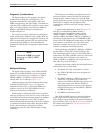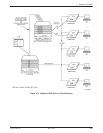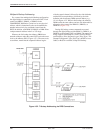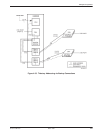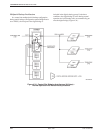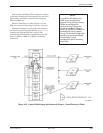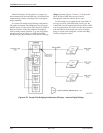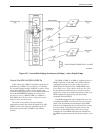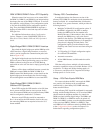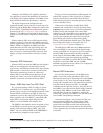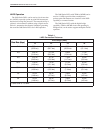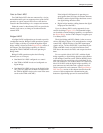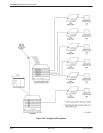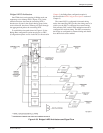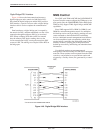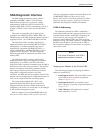
COMSPHERE 3600 Series Data Service Units
4-46 March 1999 3610-A2-GB41-60
DBM-V/DBM-S/DBM-D Dial on DTR Capability
When the central site loses access to its remote DSUs,
the DBM-Vs, DBM-Ss, and DBM-Ds can initiate backup
based upon the state of the DBM’s DTR lead. To activate
this capability, set the Primary Core configuration option
to Yes and set the DTRCallCon configuration option to
Orig. Then, the DBM-V/DBM-S/DBM-D originates a
backup call when DTR is raised and drops the call when
DTR goes low.
For additional information, refer to Configuration
Options, Chapter 6, in the COMSPHERE 3600 Series
Data Service Units, Models 3610 and 3611, Operator’s
Guide.
Digital Bridge/DBM-V/DBM-S/DBM-D Interface
Since both the digital bridge port and the DBM provide
a DCE interface, a digital bridge interface or crossover
cable is used to complete the communication path (refer
back to Figure 4-28).
The digital bridge broadcasts data from the controlling
DTE to all ports in the digital-sharing group, even if the
DBMs connected to the ports are not in Dial Backup
mode with an active call: the data is simply ignored by the
DBMs.
When a call has been established between a central-site
DBM and a remote DBM, the DBM-V, DBM-S, or
DBM-D enters Dial Backup mode, accepts data from the
digital bridge port, then transmits data over the backup
line and through the remote DBM to its associated DTE.
Digital Bridge/DBM-V/DBM-S/DBM-D –
Switched LSD Operation
Some DTEs require the LSD interface to be ON when
data is present and Off when no data is present. In this
case, the connected DBMs and associated tributary DBMs
must be configured to enable the V.13 feature.
However, most DTEs that would be connected to
Port 1 do not utilize the LSD interface lead. In this case,
the connecting DBMs are not required to have the V.13
feature enabled.
Tributary DSU Considerations
In multipoint backup, the firmware version of the
tributary DSU-DBM in a multipoint circuit determines the
features available. It is recommended that all tributaries
have Release 2.4 or greater firmware, which provides the
following features:
• Multiple Call (MultiCall) configuration option. If
the DBM is triggered by the DSU to attempt
backup, the DBM calls the first number in its
Backup Directory. If that number is busy after three
attempts, the DBM places a call to the second
number in the directory. The DBM steps through all
10 entries in the Backup Directory in an attempt to
place the call, skipping all blank entries. This
configuration option gives the tributaries more
flexibility and a better success rate when calling the
bridge.
• V.13 Signaling (V.13 Signl) configuration option
for switched LSD emulation.
• Automatic restoration.
• All the DBM features available under the earlier
release.
With the earlier release, multiple call and automatic
restoration capabilities were not available. Release 4.25 is
required for 14.4 kbps and 56 kbps backup speeds via
4-wire access, and release 6.18 is required for 56 kbps
backup speeds via 2-wire access.
Setup – DSU Rate Equals DBM Rate
For a network where the DSU rate equals the DBM
rate, partial or full backup can be accomplished
automatically by the tributary DSU-DBM when they
detect network failures.
Each tributary DSU should be configured for automatic
backup, and the Backup Directory of its associated DBM
should contain the telephone number of a central-site
DBM associated with the digital bridge. The DBMs and
DBM-Vs, DBM-Ss, or DBM-Ds need to be paired off
and, in each DBM, a pointer set to the telephone number
of the associated DBM-V, DBM-S, or DBM-D. Thus,
each DBM will call a different central-site DBM. (Refer
to the Configuration Branch section in Chapter 5 for
further details regarding configuration options.)



